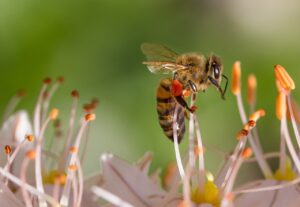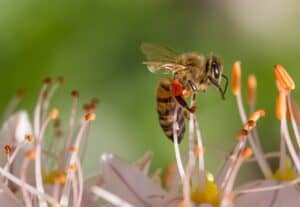Honey yields have long been on the decline. Scientists now know why
 6 Januari 2024
6 Januari 2024
Photo: Pexels
Honey bees, along with other insects, have fallen on hard times across the planet owing to habitat loss, pesticide use and climate change. In tandem, honey yields have also been on the decline since the 1990s.
A definitive answer as to the reasons for this decline has remained elusive, but scientists at Pennsylvania State University say they might finally have found it after analysing a half century’s worth of data from across the United States on such variables as average yield per colony, land use, land productivity, herbicide use, climate and weather anomalies.
We have already known that pesticide use can harm bees over the long term while heat waves reduce their ability to pollinate. Now the new research has uncovered other factors that are also at play.
“What’s really unique about this study is that we were able to take advantage of 50 years of data from across the continental U.S.,” notes Christina Grozinger, a professor of entomology and director of Penn State’s Department of Entomology and Center for Pollinator Research. “This allowed us to really investigate the role of soil, eco-regional climate conditions, annual weather variation, land use and land management practices on the availability of nectar for honey bees and other pollinators.”
What Grozinger and her colleagues have found, as they detail in their study, is that changes in honey yields were linked to the use of herbicides and land while weather anomalies also had an impact.

“[C]limate conditions and soil productivity — the ability of soil to support crops based on its physical, chemical and biological properties — were some of the most important factors in estimating honey yields. States in both warm and cool regions produced higher honey yields when they had productive soils,” they report.
“The eco-regional soil and climate conditions set the baseline levels of honey production, while changes in land use, herbicide use and weather influenced how much is produced in a given year,” they add.
After the early 1990s climate became increasingly tied to honey yields as per the data examined, according to Gabriela Quinlan, a postdoctoral research fellow at the Center for Pollinator Research.
“It’s unclear how climate change will continue to affect honey production, but our findings may help to predict these changes,” Quinlan says. “For example, pollinator resources may decline in the Great Plains as the climate warms and becomes more moderate, while resources may increase in the mid-Atlantic as conditions become hotter.”
One key factor in lower yields in a lack of enough flowers for bees to gather enough pollen and nectar for food.
“A lot of factors affect honey production, but a main one is the availability of flowers,” explains Grozinger. “Honey bees are really good foragers, collecting nectar from a variety of flowering plants and turning that nectar into honey. I was curious that if beekeepers are seeing less honey, does that mean there are fewer floral resources available to pollinators overall? And if so, what environmental factors were causing this change?”
This is where the importance of soil productivity enters the picture. It is not only the nutrient content of the soil, but its other features like temperature, texture and structure also affect pollinator resources, the scientists argue, noting that far less research has been done on these latter aspects.
For instance, decreases in land used for soybean cultivation and increases in land earmarked for the Conservation Reserve Program to protect pollinators both resulted in positive effects on honey yields.
Increased use of herbicides, meanwhile, decrease honey yields, “potentially because removing flowering weeds can reduce nutritional sources available to bees,” the scientists say.
“Our findings provide valuable insights that can be applied to improve models and design experiments to enable beekeepers to predict honey yields, growers to understand pollination services, and land managers to support plant-pollinator communities and ecosystem services,” Quinlan says.
The post Honey yields have long been on the decline. Scientists now know why appeared first on Sustainability Times.
